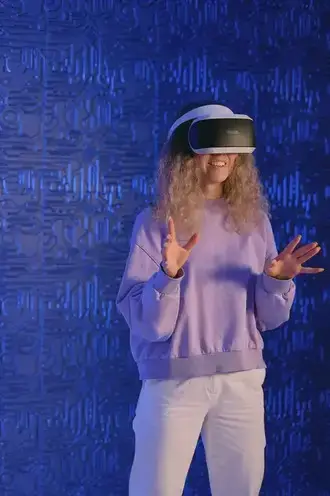
Virtual Reality Dating
- Share
- Share
- Share
- Share
Table of Contents
I. Introduction
In a world where technology continuously reshapes our social interactions, virtual reality (VR) dating emerges as the latest frontier in finding love and companionship. This innovative approach transcends traditional online dating, offering immersive and interactive experiences with potential partners. Thanks to significant technological advancements, VR dating has become accessible and affordable for everyday users. These developments enhance the visual and sensory aspects of digital interaction, opening new avenues for emotional and romantic connections.
This article explores the burgeoning world of VR dating, highlighting how it revolutionizes the dating scene. By offering unprecedented ways for people to connect, interact, and explore relationships, VR dating provides a glimpse into the future of personal connections. It blurs the lines between physical and virtual realms of romance, creating a new pathway for finding love in the digital age.
II. Understanding Virtual Reality Dating
What is VR Dating?
Virtual Reality (VR) dating represents a revolutionary step in online romance, offering an experience that differs significantly from traditional online dating. Unlike conventional dating platforms, which rely on text, photos, and video calls, VR dating transports users into a three-dimensional world. Here, they can interact with potential partners in a virtual space.
How Does VR Dating Work?
To participate in VR dating, users wear headsets and use controllers or hand-tracking technology to navigate and engage within a digitally constructed environment. This setup allows a range of activities, from simple conversations in a virtual café to adventurous outings like exploring a digital version of Paris.
Technology Behind VR Dating Platforms
VR dating platforms blend advanced software and hardware. High-quality graphics create lifelike environments and avatars, while VR headsets provide immersive visual and auditory experiences. Algorithms match users with potential partners based on preferences and interactions. Some platforms even experiment with haptic feedback systems, simulating physical sensations to add realism to the virtual dating experience.
III. Popular VR Dating Platforms
VRLoveFinder
“VRLoveFinder” offers realistic date settings, such as beach sunsets or cozy cabins, allowing users to choose their ideal date environment.
HeartSpace VR
“HeartSpace VR” focuses on deep compatibility by integrating personality tests and interest-based matching within its virtual framework.
CosmoMeet
“CosmoMeet” stands out with social VR dating events like speed dating sessions and themed mixers, providing a communal dating experience in the virtual world.
These platforms demonstrate how VR technology is revolutionizing dating, offering experiences that go beyond traditional online dating.
IV. The VR Dating Experience
Immersive Dating Scenarios
Embarking on a VR date feels like stepping into a new realm, where the limitations of physical distance and conventional environments no longer apply. Users are represented by customizable avatars, ranging from realistic to fantastical, allowing for creative self-expression.
Shared Activities and Unique Interactions
One of the most distinctive features of VR dating is the ability to engage in activities together. VR platforms offer more than just conversations; couples can play games, solve puzzles, or enjoy virtual experiences like concerts or art exhibits. This shared approach fosters organic conversations and deeper connections.
Real-Life Experiences in VR
Many users have shared unique experiences through VR dating. Sarah from New York and her date from London watched virtual fireworks over Tokyo Bay, creating a surprisingly intimate moment despite the distance. Another user, Mark, enjoyed a virtual escape room challenge with his date, which served as a fun icebreaker and a way to gauge compatibility.
V. Benefits of VR Dating
Enhanced Interactivity and Immersion
VR dating elevates the dating experience with heightened interactivity and immersion. The realistic 3D environments foster deeper connections as users engage in shared activities and nuanced non-verbal communication, such as gestures and proximity.
Inclusivity for All
VR dating is especially inclusive, providing a comfortable space for those with mobility challenges or social anxieties. It allows individuals to connect based on shared interests and personalities without the physical or social barriers of traditional dating.
Safety and Convenience
VR dating provides a safe platform for getting to know someone while maintaining physical separation. It eliminates the need for travel, making it ideal for busy individuals or those in remote areas.
VI. Challenges and Ethical Considerations
Lack of Physical Presence
Despite the benefits, VR dating lacks the physical presence and emotional nuances of in-person interactions. This absence can impact the perceived depth and authenticity of connections formed in virtual spaces.
Privacy and Data Security
Privacy concerns also arise in VR dating. Users must be aware of data vulnerabilities, as personal interactions in virtual settings can be more susceptible to breaches.
Impact on Real-World Social Skills
Prolonged use of VR dating might hinder real-world social skills. Overreliance on digital interactions can make navigating face-to-face encounters more challenging, affecting overall social confidence.
VII. The Future of VR Dating
Emerging Technologies
The future of VR dating promises further advancements, such as enhanced haptic feedback that allows users to experience a sense of touch. Integration with AI could lead to personalized and intuitive dating experiences, suggesting highly compatible matches and tailored environments.
Hybrid Experiences
The trend towards blending augmented reality (AR) with VR will make virtual dating more relatable, bridging digital and physical interactions. Additionally, potential integrations with social media platforms may offer seamless transitions from networking to dating.
VIII. Conclusion
Virtual Reality dating marks a significant shift in romantic connections, combining advanced technology with the timeless pursuit of companionship. It offers immersive and inclusive platforms that transcend traditional barriers. However, balancing these technological advancements with genuine human connections remains crucial. As VR dating evolves, it will likely become a core aspect of how we experience love in a digital world.
